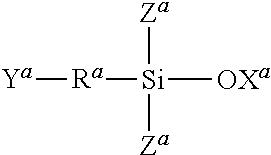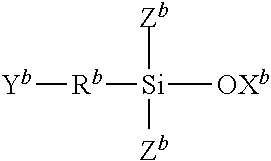Organosilicate resin formulation for use in microelectronic devices
a technology of organosilicate resin and microelectronic devices, which is applied in the direction of instruments, photomechanical devices, coatings, etc., can solve the problems of affecting the use of the device, so as to increase the need, increase the need, and increase the effect of light scatter
- Summary
- Abstract
- Description
- Claims
- Application Information
AI Technical Summary
Benefits of technology
Problems solved by technology
Method used
Image
Examples
example 1
[0138]A) Synthesis of 90 / 10 Mole Percent Vinyl / Phenyl Organosilicate
[0139]A 250 ml, 3 neck round bottom flask is placed in a 20° C. water bath and fitted with a stirrer connected to an air motor, a water jacketed condenser, a thermocouple connected to a temperature controller, and an addition funnel. 21.6 Grams (1.2 moles) of acidified water (3N acetic acid) is added to the flask. 53.3 Grams (0.360 moles) of vinyltrimethoxysilane and 7.94 grams (0.040 moles) of phenyltrimethoxysilane are pre-mixed and added to the addition funnel. The silanes are added to the reactor over 45 minutes. After the addition is complete the water bath is removed and a heating mantle placed under the flask. The addition funnel is removed and a dean-stark trap and a nitrogen sweep line are attached. The solution is slowly heated to 100° C. While heating, methanol and acetic acid are collected in the trap. When the reaction reached 100° C., 100 grams of propyleneglycol monomethylether acetate are added. The ...
example 2
[0144]Photo hard mask compositions for imaging are prepared by adding 8 percent (based on resin solids) of a cationic photoacid generator comprising mixed triarylsulfonium hexafluoroantimonate salts (CYRACURE® UVI-6976 available from The Dow Chemical Company) to representative organosilicate resins (100 percent vinyltrimethoxysilane or a mixture (95:5 mole:mole) of vinyltrimethoxysilane and phenyltrimethoxysilane). Compositions are diluted to 15 percent solids using propylene glycol methyl ether acetate solvent (Dowanol™ PMA from The Dow Chemical Company) and then filtered through 0.22 μm PTFE filters. Approximately 2 ml of the photo hard mask composition is dispensed (puddled) onto a static 4 inch (10 cm) silicon wafer. After dispensing, the wafer is initially spun at 500 RPM for 5 seconds, followed by a second spin cycle at 2000 or 5000 RPM for 30 seconds. After applying the photo hard mask composition, the coated silicon wafer is pre-exposure baked on a direct hotplate (Model VBS...
example 3
[0147]90:10 Vinyl:Phenyl Organosilicate Resin (MW=2120).
[0148]The reaction conditions of Example 2 are substantially repeated using a 90:10 mole:mole mixture of vinyltrimethoxysilane and phenyltrimethoxysilane resins. Samples included 8 percent CYRACURE® UVI-6976 and are spun at 500 RPM for 5 seconds, followed by a second spin cycle at 5000 RPM for 30 seconds, and then pre-exposure baked in an oven set at 55° C. for 60 seconds. After exposure, films are post-baked in an oven set at 180° C. for 60 seconds. Films are developed in 2.38 percent aqueous TMAH. Results are contained in Table 3.
[0149]
TABLE 3RadiationSmallest Via thatDosage (mJ / cm2)completely opened (μm)50.03545.62530.92514.7156.715
PUM
| Property | Measurement | Unit |
|---|---|---|
| dielectric constant | aaaaa | aaaaa |
| temperatures | aaaaa | aaaaa |
| temperatures | aaaaa | aaaaa |
Abstract
Description
Claims
Application Information
 Login to View More
Login to View More - R&D
- Intellectual Property
- Life Sciences
- Materials
- Tech Scout
- Unparalleled Data Quality
- Higher Quality Content
- 60% Fewer Hallucinations
Browse by: Latest US Patents, China's latest patents, Technical Efficacy Thesaurus, Application Domain, Technology Topic, Popular Technical Reports.
© 2025 PatSnap. All rights reserved.Legal|Privacy policy|Modern Slavery Act Transparency Statement|Sitemap|About US| Contact US: help@patsnap.com



